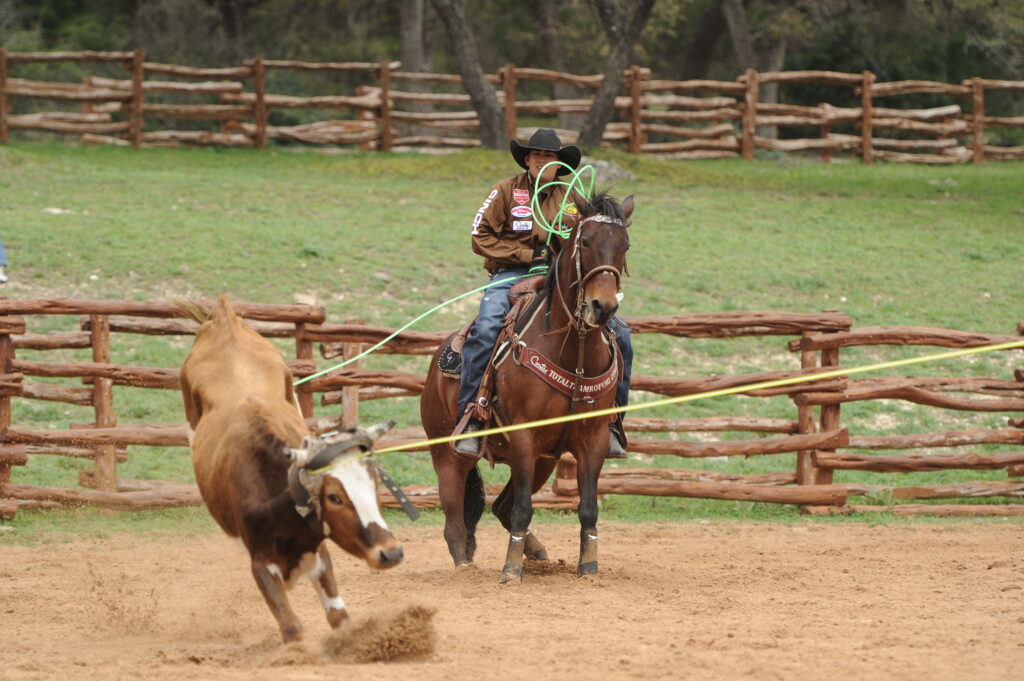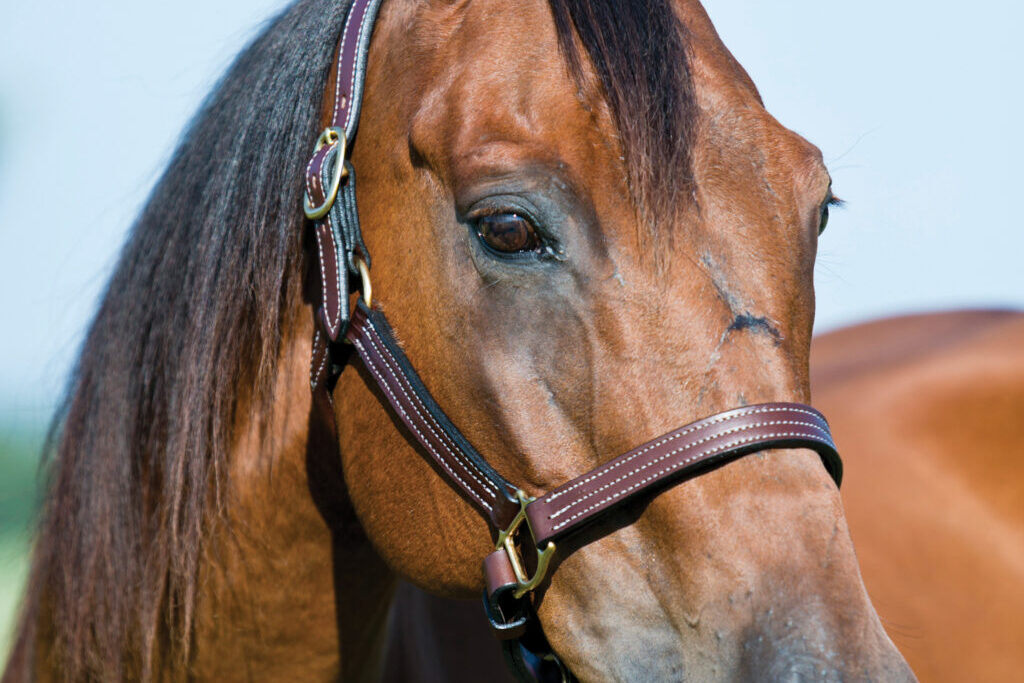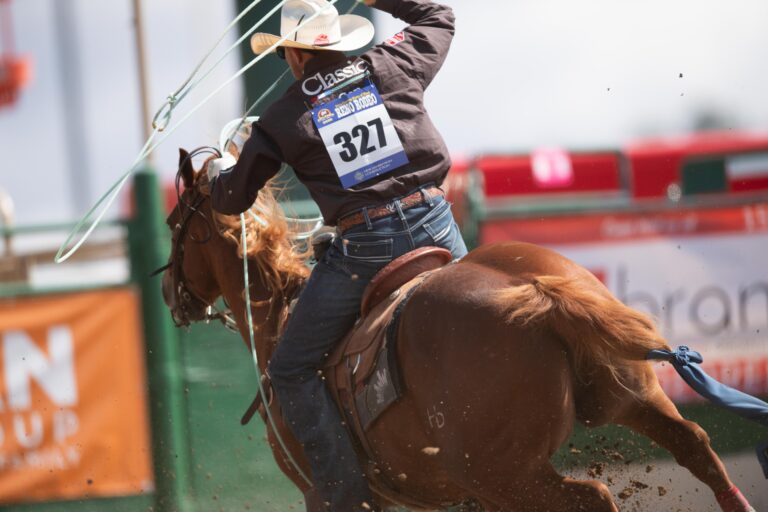Plenty of GOATs agreed that the longest-lasting head horses are made of heart, crossed on toughness. Now, we tip our hats to even more road-warrior heel horses. With them, being in a hurry seems to be the common denominator. That is, of course, along with love of the game.

We’ve Got a Runner
Just about any heel horses that lasted up to 15 years on the gold-buckle highway had both lightning speed and the fire-breathing motor that goes with it. Not many people know that Hall-of-Famer Rich Skelton’s late, great Roany backed into virtually every box he encountered over his 12-plus years on the road on a hefty dose of acepromazine. Switchblade’s face was plenty scarred from spooking and running off, but the super-fast bay hummed along for a steady 15 years under four NFR veterans. And what made Clay “Champ” Cooper’s immortal Ike so good over a full dozen years? He was a virtual runaway.
“I’d let people ride him that asked to get on, and he’d scare them a little bit,” Cooper recalled of the horse on whom he set an NFR average record that lasted 27 years. “He was basically running off down the arena, but then when the steer turned, he was in the right spot.”
That’s exactly how three-time World Champ Jade Corkill describes his first trip on Jackyl—the late, legendary dun that earned $2 million over 16 years for six veteran heelers. Both Ike and Jackyl were plenty “watchy.” Neither wanted petting nor craved affection. They wanted left alone to do their job, and they’d give you 100% every trip. Farriers couldn’t get around Jackyl, and Ike was bad to set back. But he could also mortally fly. He was Truly Truckle-bred on top, out of an own daughter of Driftwood Ike.
Plenty of speed, too, characterized the mare that kicked off Allen Bach’s extraordinary Hall-of-Fame career. Papoose was so miserable to warm up that Peggy Bach sometimes had to do the deed.
“I’d just get fighting mad,” Allen said. “That mare was so ignorant to ride that she’d have me so upset I could barely rope.”
But on her, Bach won the BFI and Salinas his very first year. Not only that, but she was it. She gave Bach every jackpot run, every practice run and every rodeo run from the mid-1970s through the mid-80s. She was never out of position because of how quick her feet were.
Point A to Point B
Another of the quickest-footed mounts in history was also one of the longest lasting. Freckles Taz garnered five different top-three finishes for Heel Horse of the Year over a full decade for Kinney Harrell. The year after Bach borrowed Jackyl to win his third world title, he borrowed the “ridiculously fast” Taz to win the NFR average with Chad Masters, plus a new earnings record and gold buckle for Masters.
“Taz could run like the wind,” Bach recalled. “He kind of thought he should run by the corner, so I had to ride so far back that he could not get by. That’s how I rode him at the NFR, like two strides back. And the way Chad handled them made it look easy. But it’s not just any horse that you could hold so far back and he’d still get there, where you could rope fast.”
Bach nailed down another gold buckle on Dunny, eight years after the mighty little two-time PRCA/AQHA Heel Horse of the Year won an AJRA national title with 16-year-old Steve Northcott and then packed him to five NFRs. Northcott said Dunny—who enjoyed humping up during a cool-morning slack as he tried to dally—is still the fastest horse he’s ever saddled. It’s no wonder. The Triple-Chick-bred dun that barely reached 14 hands was out of an own granddaughter of Seattle Slew.
“He could run right with Scooter at Salinas,” Northcott marveled. “After Charles [Pogue] nodded, I’d watch and Dunny’s head would stay right even with Scooter’s hip all the way to the steer.”
He was just a kid when his dad (at first) refused to buy Dunny, saying he was too small; wouldn’t last six months. Fourteen years, two BFI championships, 10 straight NFRs and a gold buckle later, Joel Bach had him back at the junior rodeos.
“I don’t have anything to back this up,” Allen said, “but I think it’s the high-energy component of these horses that makes them quick-footed. It’s like people: some are just lethargic and some can go hard for a long time.”
“Wound tight” might be another way to say “high energy,” but either way, Allen might not be right. Adrenaline is a known pain-reliever. In some guys—and in some horses—it pumps extra hard.
“Dunny could be sore-footed, but when Steve backed him in that box, it was just like giving him Bute,” Allen recalled. “You could just feel his little heart get to pumping, and the last thing he thought about was pain.”

Devotion
Is it coincidence that Allen Bach, in his 30 NFR appearances, actually rode five of the 10 longest-lasting heel horses in history? He said it was a big-headed grade horse out of Mexico that taught him what he needed to ride later. Hollywood would quiver and threaten to flip over every time he was cinched up and, though he wasn’t “ate up with speed,” he gave everything he had, every time.
“He could control his footwork,” said Bach, who got a good seven years out of Hollywood. “He could take a hellacious jerk from a steer running up the rope, and then on the very next steer, it was like, ‘Go ahead, hit me again.’ It was a Rocky Balboa kind of deal. Some horses take one little hit and turn into a coyote. But this horse was tough; a warrior.”
And, while Bach is fairly certain horses don’t have human minds, he’ll swear up and down that Dunny absolutely loved team roping.
“With people, you can tell when they hate their job,” he said. “I’ve probably had 50 horses in my lifetime that hated roping. I think Jackyl loved it. He had to love it.”
Jackyl, for the record, was sold to Magnus in the ’90s because his owner thought he wouldn’t stay sound. He won his last NFR go-round at the age of 24, after winning everything possible to win. In ’06, Bach only ran 13 steers on Jackyl, despite Jones assuring him the old horse could take NFR practice runs.
“I roped one steer one day, and I had such respect for that horse, I got off,” Bach said. “The next day I ran one more. And one more the third day. We placed in seven rounds, and I won the average with a money record and won the world.”
Travis Graves got 14 years out of Superstar by not using him up. Plus, he said, the gelding had the bigger bone and good conformation that helped him last through several NFRs, three Wildfire wins, a BFI victory and more.
“I tried to take really good care of him,” said Graves, who used a Coats saddle. “I knew he was my ticket to make the Finals. If it was muddy or the ground was bad, I tried not to ride him.”
Starbucks, who gave five-time NFR heeler Ryan Motes a good 15-plus years, was a bit like Jackyl as he got older, in that he didn’t want to stay home. During Starbucks’ last season on the road, Motes joked that, “You ride him at the house and he feels like a kid’s horse, but get him to a rodeo and he knows half the words to the National Anthem, and he’s lapping the warm-up arena.”

Love of the Game

Veterinarians added years of longevity to these legends. Dr. Richard Galley’s X-rays helped Cooper’s farrier keep Ike sound. As for Dunny, he’d run so many thousands of steers—literally 50 to 60 a day—that Bach bought him crippled. But under the late Dr. Van Snow’s guidance, they cut his runs by a third, nerved him and used medication to haul him pain-free five more years.
Then, of course, there’s self-care. Cooper laughs about Ike’s penchant for sleeping on the trailer.
“I’d go to get him off after a long haul and he’d be standing there asleep,” Cooper recalled. “He would sleep standing at the rodeo. Every now and then he’d startle and kind of jump and look around when he woke himself up.”
Cooper hauled a second and third horse, to save Ike for the high-stakes runs. At 21, he was still sound enough that Cooper ran a few on him in preparation for the 2006 NFR. But Cooper knew he’d never forgive himself if Ike got hurt, so he sent him back to retire with Ozzie Gillum, who’d raised and trained him.
“When I quit hauling him, he lived in a pasture next to Rickey Green’s arena,” Cooper remembered. “Anytime Rickey would rope or give lessons, he’d holler at me and say, ‘Look at this horse!’ Ike would be right behind the boxes and stand there and watch however long they’d rope.”
Another wonder-horse that made the career of more than one man was Ricky, the blaze-faced sorrel on whom Lee Woodbury won the 1983 NFR average, on whom Cooper won the BFI and won the world in ’88, and on whom Bach won the world in ’90, followed by five straight NFR round wins in ’93.

But just as many horses were one-man shows, from Superstar to Starbucks to Cesar de la Cruz’s great Johnny Ringo over 14-plus years. In Bach’s opinion, longevity most often results from the magic connection between a particular horse and rider.
“Look at Scamper,” Bach said of the Hall-of-Fame barrel horse. “That sucker was tough—10 straight years of hauling and winning and I never saw him limp, even with a knot on his knee. But Charmayne rode him so precisely perfect. And Charles was that way with Scooter. I don’t think we’d have the same result with, say, Sherry and Scamper, or Jake and Scooter, or me and Roany.”
There aren’t enough pages here to list all the gritty heel horses that spent the better part of a decade on the road. In fact, last month we forgot to include Nickolas—the sorrel two-time World Champion head horse that gave Matt Sherwood 14 long years. It’s bound to happen here, too.
So many others dropped the flag a few million times, from Cody Cowden’s Blue to Leo Camarillo’s Stick; from Rich Skelton’s Chili Dog to Jade Corkill’s Ice Cube. And credit for a million miles over at least a decade goes also to Paul Eaves’ Cadillac, Denny Watkins’ Banner and Kory Koontz’s Iceman.
To some extent, they all had a supernatural will to win that Bach relates back to basketball legend Michael Jordan. Bach will never forget, at Red Lodge, Montana, when he borrowed the longest-lasting elite heel horse in history and Jackyl pulled off the impossible.
“That was always the fastest rodeo of the Fourth,” Bach recalled. “This steer comes out, and I miss the haze. He cuts so hard right, over to the grandstand. Joel hooks him way out there and brings him straight back over himself. Before I can even think to use my left leg or inside rein to try to help Jackyl get in some kind of position, that horse literally sidepasses at a dead run to get to the outside and make that pocket, gets his body framed up and gives me a shot like I’m roping the Pipes. We won the rodeo. Coolest feeling of my life. He was Michael Jordan.”
It’s comparable to the real Jordan’s infamous “flu game” of the 1997 NBA Finals. In Game 5, MJ dropped 38 points in 44 minutes, including the buzzer-beating 3-pointer, to lead the Bulls to the series win over the Jazz—all while about to pass out from food poisoning the night before and in desperate need of an IV.
Only freaks want to win that bad. And only horses with big motors that truly love the game will do whatever it takes on steer after steer after steer, for year after year after year.











